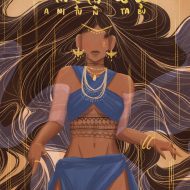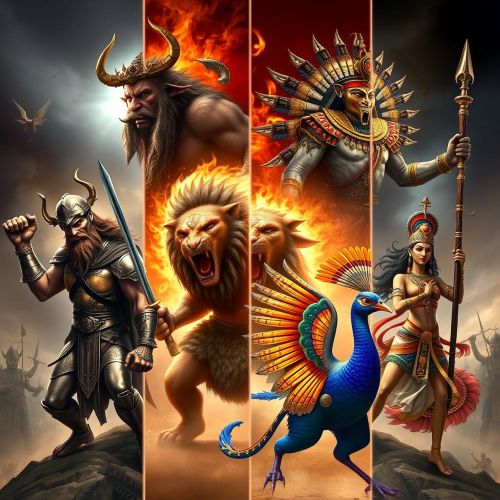Anitun Tabu : Goddess of WInd
Listen
At a glance
| Description | |
|---|---|
| Origin | Philippine Mythology |
| Classification | Gods |
| Family Members | N/A |
| Region | Philippines |
| Associated With | Rain, Wind |
Anitun Tabu
Introduction
Anitun Tabu, the goddess of wind and rain, holds a paramount role in Philippine folklore. Her narrative is a captivating blend of enigma and reverence, symbolizing the intricate equilibrium that both sustains and occasionally tests life on this tropical archipelago. In the ancient Tagalog culture, Anitun Tabu was often held responsible for the occurrence of “ambon,” a gentle rain. Interestingly, prior to the colonial era, marrying in the rain was considered auspicious, signifying Anitun Tabu’s contentment. This belief vividly illustrates the profound influence Anitun Tabu held in the lives of ancient Filipinos.
Physical Traits
Physical attributes of Anitun Tabu are not extensively described in traditional Philippine mythology. Instead, her essence is primarily associated with her roles and attributes related to the wind and rain, as well as her importance in the lives of the people. She is more of a spiritual and elemental deity than a figure with distinct physical characteristics.
In many depictions, if any, Anitun Tabu might be portrayed as a beautiful and ethereal being, often with a connection to natural elements like the wind and water. However, these depictions can vary, and her portrayal may differ depending on regional beliefs and artistic interpretations. In the end, her significance lies more in her mythological roles and symbolism than in specific physical features.
Family
Anitun Tabu originates from the Panay-Bukidnon community, an indigenous group residing in the central region of the Philippines, predominantly on the island of Panay. These people share a profound connection with the natural world, and Anitun Tabu stands as a testament to their deep reverence for the elements. In Zambales, she is also known as Anitun Tauo. It is said that she once held a position of great eminence among the gods. However, owing to her excessive arrogance, she experienced a significant demotion in rank. This facet of her narrative underscores the cherished Filipino values of humility and respect, where arrogance is viewed as a detrimental trait capable of leading to one’s eventual downfall.
Other names
Anitun Tabu, also known by variations such as Anitun Tauo or Anitun Tabo, stands as a deity deeply entrenched within the indigenous belief systems of the Philippines. The very name “Anitun Tabu” carries profound symbolism. “Anitun” alludes to the gentle wind, a caressing breeze that offers respite from the day’s scorching heat. Meanwhile, “Tabu” symbolizes rain, the life-sustaining water that nurtures the earth and upholds the vibrant greenery of the islands. Consequently, Anitun Tabu personifies the harmonious interplay of these two indispensable elements, representing the delicate equilibrium intrinsic to nature itself.
Powers and Abilities
Anitun Tabu wields authority over the elements of wind and rain. She is known for her capricious nature, marked by a hint of arrogance. It is believed that her emotions are reflected in the weather patterns. When a gentle rain, known as ‘ambon,’ graces the land, it is interpreted as a sign of Anitun Tabu’s contentment. Conversely, the presence of a storm is seen as an indication of her displeasure. In the predominantly agrarian society of the Philippines, the livelihoods of many depend on the unpredictable forces of nature. Farmers hold Anitun Tabu in high regard, seeking her blessings for abundant harvests. The rains she sends replenish the soil, nurturing crops, while her gentle winds aid in the dispersal of pollens and seeds, fostering the proliferation of plant life.
Anitun Tabu is believed to possess the ability to influence weather patterns. She embodies the soothing zephyrs that provide relief from the tropical heat and the light drizzles that refresh the land. Yet, akin to nature itself, she can be both nurturing and unpredictable, occasionally unleashing storms and typhoons that challenge the resilience of the Filipino people. Among her many facets, Anitun Tabu is revered as a healer. Communities call upon her to alleviate droughts, illnesses, and other afflictions. They beseech her for robust health, recognizing her as the source of life-giving waters and comforting breezes.
Rituals and ceremonies dedicated to Anitun Tabu unfold in lush, natural settings that reflect her domain. Offerings of fruits, flowers, and symbolic items are presented in the hope of earning her favor. These rites often coincide with pivotal agricultural events like planting and harvest seasons, as well as during periods of drought or impending storms. A particularly distinctive tradition linked to Anitun Tabu is the “Pag-ipatan” ritual. Participants gather near rivers or streams, entreating her to cease the rain during a storm. They seek her mercy to prevent destructive flooding and landslides that might result from the downpour.
Modern Day Influence
Anitun Tabu transcends mere mythological character status, symbolizing the profound respect of the Filipino people for the natural world and their grasp of its capricious forces. Despite her fall from grace attributed to her arrogance, she continues to hold a significant place in Philippine mythology. Her narrative remains a poignant cautionary tale, underscoring the repercussions of hubris and the enduring value of humility.
In the heart of the Philippines, Anitun Tabu’s legacy persists as a testament to the enduring connection between the people and their natural environs. As we navigate the ever-evolving world, her gentle breezes and life-sustaining rains serve as a timeless reminder of the wisdom woven into the ancient myths and legends of the Philippines.
Related Images
Frequently Asked Questions
What is lorem Ipsum?
I am text block. Click edit button to change this text. Lorem ipsum dolor sit amet, consectetur adipiscing elit. Ut elit tellus, luctus nec ullamcorper mattis, pulvinar dapibus leo.
What is lorem Ipsum?
I am text block. Click edit button to change this text. Lorem ipsum dolor sit amet, consectetur adipiscing elit. Ut elit tellus, luctus nec ullamcorper mattis, pulvinar dapibus leo.
What is lorem Ipsum?
I am text block. Click edit button to change this text. Lorem ipsum dolor sit amet, consectetur adipiscing elit. Ut elit tellus, luctus nec ullamcorper mattis, pulvinar dapibus leo.
What is lorem Ipsum?
I am text block. Click edit button to change this text. Lorem ipsum dolor sit amet, consectetur adipiscing elit. Ut elit tellus, luctus nec ullamcorper mattis, pulvinar dapibus leo.
What is lorem Ipsum?
I am text block. Click edit button to change this text. Lorem ipsum dolor sit amet, consectetur adipiscing elit. Ut elit tellus, luctus nec ullamcorper mattis, pulvinar dapibus leo.











